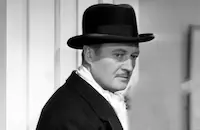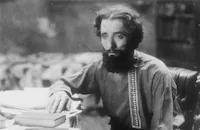Chandu the Magician

Brief Synopsis
Cast & Crew
Marcel Varnel
Edmund Lowe
Irene Ware
Bela Lugosi
Herbert Mundin
Henry B. Walthall
Film Details
Technical Specs

Synopsis
After spending three years among the yogis, Frank Chandler, having acquired hypnotic powers of the will, is given the name Chandu and told that Fate has appointed him to conquer the evil madman Roxor. With a death-ray invented by Chandu's brother-in-law, Robert Regent, whom he has captured, Roxor plans to destroy civilization so that he will be proclaimed the master of the world. After Chandu rescues the Egyptian Princess Nadji, whom he had loved in Paris three years earlier, Regent's daughter Betty Lou is abducted and taken to a slave market to force her father to divulge the secret of the death-ray to Roxor. By creating a double of himself, Chandu rescues Betty Lou, but he and Nadji are captured at an oasis when Roxor's cohort Abdullah, who hates but also greatly desires Nadji, throws tear gas in Chandu's eyes. Imprisoned, Nadji and Chandu confess their love for each other before Roxor has Chandu put into a mummy's coffin and sunk underwater. Meanwhile, when Roxor has Regent watch as the floor underneath his family gradually collapses, Regent agrees to prepare the death-ray for Roxor to save his family. While Roxor imagines the destruction of the great cities, Chandu escapes and paralyzes him with his gaze. Chandu rescues Nadji from Abdullah. The death-ray, which Regent had fixed to explode to kill himself and his family, destroys Roxor's temple. After Regent, his family, Chandu and Nadji escape, Chandu makes the clouds cover the moon and kisses Nadji.

Cast

Edmund Lowe
Irene Ware

Bela Lugosi

Herbert Mundin

Henry B. Walthall
Weldon Heyburn

June Vlasek
Nestor Aber
Virginia Hammond
Charles Stevens

Nigel De Brulier
Crew
Joseph E. Aiken
Guy Bolton
Barry Conners
Louis De Francesco
Jack Epstein
James Howe
Bradley King
Philip Klein
Paul Lockwood
Earl Luick
Walter Mayo
Max Parker
Irving Rosenberg
Harold Schuster
Harry Segall
Anthony Ugrin

Film Details
Technical Specs

Articles
Chandu the Magician
The 1932 film version of Chandu the Magician establishes Chandu's fantastic powers in the opening sequence where he telepathically levitates a rope into the air that a fellow swami climbs before vanishing at the top. Chandu then astral projects himself out of his own body and walks across burning coals without harm. But the real adventure begins after he gazes into a crystal ball and sees the kidnapping of his brother-in-law and Regent's invention by Roxor's minions. Unfolding in episodic segments like the radio serial, Chandu the Magician has a Perils of Pauline structure with a new danger and rescue occurring at regular intervals throughout its 71 minute running time.
If the storyline has a predictable familiarity, it is only because it follows the template of so many other action serials of its day such as Tarzan and The Shadow. What distinguishes Chandu the Magician from other genre efforts of the early thirties is the movie's stunning art direction, atmospheric set designs and impressive special effects.
Although co-directed by Marcel Varnel and William C. Menzies, the overall look of Chandu the Magician suggests that Menzies was the one responsible for shaping the movie's fantastical visual aesthetic. Menzies was, after all, the Oscar®-winning production designer of Gone with the Wind (1939) as well as The Thief of Bagdad (1924) and Kings Row (1942). In addition, his own films as a director demonstrate his talent for creating surreal, otherworldly environments such as Things to Come (1936), Invaders from Mars (1953) and The Maze (1953), which was originally shot and distributed in 3-D. Marcel Varnel, on the other hand, is better known for a string of popular British comedies from the late thirties and early forties for Gainsborough Pictures, particularly Oh, Mr. Porter! (1937), The Frozen Limits (1939) and To Hell with Hitler (1940). Varnel's main contribution to Chandu the Magician is most likely the comic relief which is interjected at regular intervals via the presence of Herbert Mundin as Albert Miggles, Chandu's alcoholic assistant whose drinking results in some very funny hallucinations.
In the title role of Chandu, Edmund Lowe underplays the part, projecting a Zen-like calm and steely intelligence that stands out against Bela Lugosi's more flamboyant and volatile persona as Roxor, a villain as diabolical and power hungry as Ming the Merciless (from Flash Gordon) or Fu Manchu from other popular series in the thirties. The film does traffic in negative Arab stereotypes in its depiction of Roxor and his cohort Abdulah (Weldon Heyburn) and their terrorist tactics. And the dialogue is as absurd and as cartoonish as the farfetched proceedings with Roxor making such pronouncements as "At last I'm king of all...London, New York, Imperial Rome. I can blast them all into a heap of smoking ruins...Cities of the world shall perish...All that lives shall know me as master and tremble at my work." Yet taken on its own terms, Chandu the Magician is fast paced escapism and worth seeing for several memorable set pieces such as Chandu's underwater escape from an Egyptian sarcophagus at the bottom of the Nile or Roxor's imagined destruction of key cities in his master plan or Regent testing his death ray device in his elaborate Art Deco laboratory.
While many critics at the time dismissed Chandu the Magician as lowbrow entertainment, the movie never had any pretentions toward high art and The New York Times reviewer noted its simple appeal: "On the radio the nightly recital of Chandu's adventures contrived, in the well-remembered manner of Pauline and Elmo the Mighty, to open with an escape from an impossible dilemma and to close with a plunge into a more impossible one. Not unexpectedly, this screen version has the same clutter of climaxes from which the great Chandu emerges every five minutes with the same facility. The result is whooping entertainment for the children and a series of naïvely juvenile escapades for the grown-ups."
Chandu the Magician was successful enough to spawn two sequels, The Return of Chandu (1934) and Chandu on the Magic Island (1935), both of which starred Bela Lugosi as Chandu, taking over the role from Edmund Lowe. The character of Chandu may also have inspired the comic strip Mandrake the Magician, created by Lee Falk (The Phantom) in 1934; Like Chandu, Mandrake's power resided in his ability to use hypnosis as a potent hallucinatory force against his enemies. Hollywood could do worse than attempt a revival of Chandu or Mandrake with all of the attendant special effects wizardry at their fingertips today.
Director: William Cameron Menzies, Marcel Varnel
Screenplay: Barry Conners, Philip Klein (based on the radio serial by Harry A. Earnshaw, Vera M. Oldham and R.R. Morgan.
Cinematography: James Wong Howe
Art Direction: Max Parker
Film Editing: Harold D. Schuster
Cast: Edmund Lowe (Chandu/Frank Chandler), Irene Ware (Princess Nadji), Bela Lugosi (Roxor), Herbert Mundin (Albert Miggles), Henry B. Walthall (Robert Regent), Weldon Heyburn (Abdulah).
BW-71m.
by Jeff Stafford

Chandu the Magician
Quotes
Trivia
Notes
The film was copyrighted as Chandu, the Magician. The radio serial on which this film was based consisted of nightly fifteen-minute installments and was broadcast in some areas at the same time as the film was exhibited. The serial remained on the air until 1936. Sources disagree concerning the length of the film. According to information in the Twentieth Century-Fox Records of the Legal Department at the UCLA Library, Ralph Morgan was originally cast as "Robert Regent." In 1934, Principal Pictures produced a twelve-part serial entitled The Return of Chandu, and released, in addition to the serial, two features composed of footage from the serial, The Return of Chandu (see below) and Chandu on the Magic Isle.















